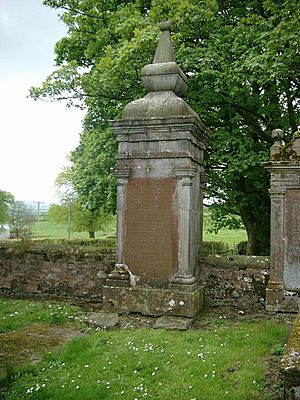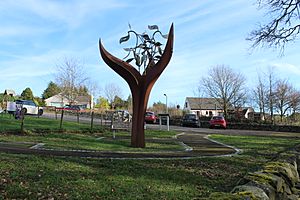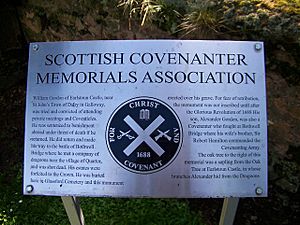William Gordon of Earlston facts for kids
Quick facts for kids William Gordon of Earlston (1614–1679) |
|
|---|---|

Headstone in Glassford Graveyard
|
|
| Personal details | |
| Born | 1614 Dalry |
| Died | 1679 Bothwell Bridge |
| Denomination | Church of Scotland |
| Spouse | Mary Hope 2nd daughter of Lord Craighall |
| Children | 13 including Alexander Gordon of Earlston |
William Gordon was a Scottish landowner and a Covenanter in the 1600s. Covenanters were people who supported the Presbyterian Church of Scotland and its independence from the king's control. William Gordon was known for his strong religious beliefs. He was also mentioned in important books of his time, like Letters by Samuel Rutherford and Scots Worthies by John Howie.
In 1664, William was sent away from Scotland. This happened because he attended religious meetings where ministers did not have the government's permission to preach. He was shot and killed near the Battle of Bothwell Bridge in 1679, after the fighting had already ended.
Contents
William's Early Life
William Gordon was born in 1614. His family lived at Earlstoun Castle. He was the second son of Alexander Gordon and Elizabeth Gordon. His father was an elder in the Church of Scotland and attended an important meeting called the General Assembly in 1638.
William studied to become a minister. When the civil war started in 1639, he joined the army under General Alexander Leslie. He was part of the group that captured Newcastle the next year.
After his older brother died, William went home to help his father. He also served on a local committee that helped with the war effort. Later, he briefly joined a rebellion to support King Charles II. However, he left because of arguments within the rebel army. He then accepted a pardon from Cromwell and returned home in 1654.
William lived a quiet life under Cromwell's rule. He even helped with local government tasks, like collecting taxes.
His Strong Beliefs
William Gordon was known for his deep religious faith. He made sure that the people who lived on his land followed religious practices. They were expected to have family worship and attend church with him every Sunday.
People also respected his ability to help with difficult moral questions. He was seen as a very wise and religious man.
Challenges After the King's Return
William Gordon and other Presbyterians were happy when King Charles II returned to the throne in 1660. This event was called the Restoration. However, William's strong religious beliefs soon caused him trouble.
In 1662, the king offered a pardon to many people. But William had to pay a very large fine of £3,500 to get his pardon. Around the same time, he was also asked to pay for damages to Drumlanrig Castle. This was related to a conflict that happened in 1650.
In 1663, William was asked to choose a new minister for the church in Dalry. The government wanted him to pick a minister who supported the king's church rules. William refused, saying he would not force a minister on the people if they did not want him.
Banished from Scotland
Because he refused to follow the government's orders, William was called before the Privy Council. This was a group of advisors to the king. They couldn't prove he had committed a crime. So, they accused him of attending "conventicles." These were private religious meetings held by ministers who were not approved by the government.
On March 1, 1664, William admitted to attending three such meetings. He also admitted that unapproved ministers had preached in his mother's house and his own home. Because he would not promise to stop attending these meetings, he was banished from Scotland. This meant he had to leave the country and could not return, or he would face the death penalty.
William went to London. But after a rebellion called the Pentland Rising was put down, he was allowed to come home. Even then, his home at Earlston was often used by soldiers who were hunting Covenanters. William even had to build a secret hiding place in the nearby forest.
The Battle of Bothwell Bridge
William Gordon supported the Covenanter uprising that led to the battle of Bothwell Bridge on June 22, 1679. He was not able to be there for the actual battle. However, he arrived shortly after it ended.
He met a group of soldiers who demanded he surrender. William hesitated for a moment and was immediately shot and killed. His body was found and buried by his sister-in-law in Glassford churchyard. A simple stone pillar was put up to mark his grave. This monument has since been repaired and now has an inscription. Even after his death, the Privy Council officially declared him guilty and ordered his property to be taken away.
William's Family
William Gordon's wife, Mary Hope, survived him. She was the second daughter of Sir John Hope. She had a very difficult time, but she managed to keep her right to live on the family estates.
William and Mary were married on October 26, 1648. They had thirteen children, but most of them died young. Only three sons and one daughter lived to be adults:
- (1) Alexander Gordon of Earlston
- (2) Sir William Gordon of Afton, who became a high-ranking officer in the army. He was made a baronet (a special title) in 1706.
- (3) John, who became an army surgeon.
Their daughter, Margaret, married James Holborn in 1682.
William Gordon in Fiction
The author S.R. Crockett wrote stories about the Gordon family of Earlston. His book Men of the Moss Hags tells the story of the Gordons. It was first published in a magazine and then as a book in 1895. William Gordon, who shares the same name as our subject, is the hero of this story.
A follow-up book, Lochinvar, was published in 1897. Both of these novels became very popular around the world.



